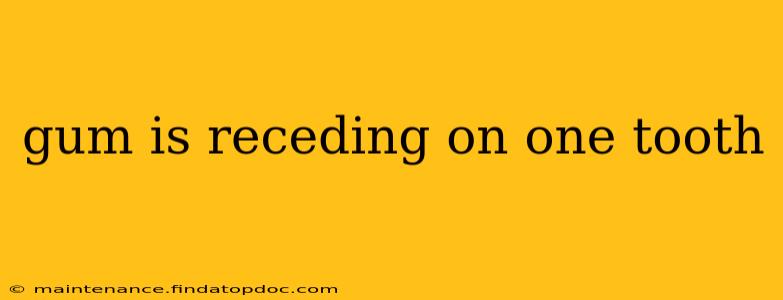Gum recession, where the gum tissue pulls back from the tooth, is a common dental problem. While it can affect multiple teeth, it's often noticed first on a single tooth. This can be alarming, but understanding the causes and available treatments can alleviate anxiety and encourage proactive care. This comprehensive guide will explore the reasons behind gum recession on one tooth, various treatment options, and preventative measures to protect your smile.
What Causes Gum Recession on One Tooth?
Gum recession on a single tooth isn't always easy to pinpoint, but several factors can contribute:
-
Aggressive Brushing: Brushing too hard or using a hard-bristled toothbrush can damage the gum line over time, leading to recession. This is often concentrated on a single tooth due to brushing habits.
-
Gum Disease (Periodontitis): This is a major culprit. Bacteria build-up causes inflammation and infection, destroying the supporting tissues around the teeth. If left untreated, periodontitis can lead to significant gum recession, often affecting one tooth initially before spreading.
-
Genetics: Some individuals are genetically predisposed to gum recession, regardless of their oral hygiene habits. Family history of gum disease significantly increases your risk.
-
Teeth Grinding (Bruxism): This puts excessive pressure on the teeth and gums, potentially leading to recession, particularly on the teeth most involved in grinding.
-
Misaligned Teeth or Bite: Malocclusion (incorrect bite) can put uneven pressure on specific teeth, resulting in localized gum recession.
-
Trauma: A direct injury to the gum tissue, such as a fall or blow to the mouth, can cause noticeable recession on the affected tooth.
How is Gum Recession on One Tooth Treated?
Treatment depends on the severity of the recession and the underlying cause. Your dentist will conduct a thorough examination to diagnose the problem accurately:
-
Scaling and Root Planing: For gum disease, this deep cleaning procedure removes plaque and tartar from below the gum line, allowing the gums to heal.
-
Gum Grafting: This surgical procedure involves taking gum tissue from another area of the mouth (often the palate) and grafting it onto the receding area. This is a common and effective solution for moderate to severe recession.
-
Connective Tissue Graft: This involves using a combination of gum tissue and underlying connective tissue to improve the graft's stability and effectiveness.
-
Guided Tissue Regeneration (GTR): This technique uses a special membrane to encourage the growth of new gum tissue and bone.
-
Enamel Matrix Derivative (EMD): EMD is a protein that may stimulate the regeneration of periodontal tissues.
Can Gum Recession on One Tooth Be Prevented?
While genetic predisposition can play a role, many cases of gum recession are preventable:
-
Proper Brushing Technique: Use a soft-bristled toothbrush and brush gently in small, circular motions.
-
Regular Flossing: This removes plaque and food particles from between teeth, preventing gum inflammation.
-
Regular Dental Checkups: Early detection and treatment of gum disease are crucial in preventing further recession.
-
Mouthguard for Bruxism: If you grind your teeth, a mouthguard can protect your teeth and gums from excessive wear.
-
Addressing Misaligned Teeth: Orthodontic treatment can correct misalignment and reduce uneven pressure on the teeth.
What are the Long-Term Effects of Untreated Gum Recession?
Ignoring gum recession can have serious consequences:
-
Tooth Sensitivity: Exposed tooth roots are highly sensitive to hot and cold temperatures and sweet or acidic foods.
-
Tooth Decay: The exposed root surface is more prone to decay.
-
Tooth Loss: In advanced cases, severe bone loss can lead to tooth loss.
Does Gum Recession on One Tooth Always Require Treatment?
Not necessarily. Minor gum recession that's not causing any symptoms might not require immediate intervention. However, regular monitoring is important to catch any progression. Your dentist will assess the situation and recommend the best course of action based on your individual needs.
What Happens If I Don't Treat Gum Recession?
Untreated gum recession can lead to increased tooth sensitivity, cavities on the exposed root surfaces, and eventually, tooth loss due to bone loss and periodontal disease.
Is Gum Recession Painful?
Not always. In its early stages, gum recession may not cause any pain. However, as it progresses and exposes the tooth roots, sensitivity to temperature changes and pressure can develop, eventually leading to discomfort.
This article provides general information and should not be considered medical advice. Consult your dentist for diagnosis and treatment of gum recession. Early intervention is key to preserving your oral health.
